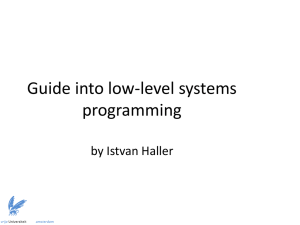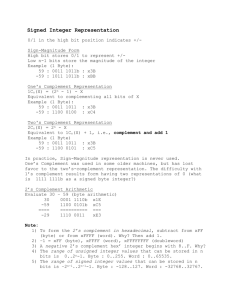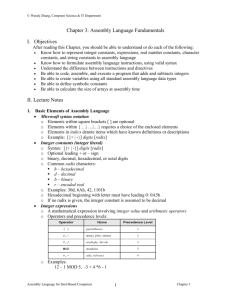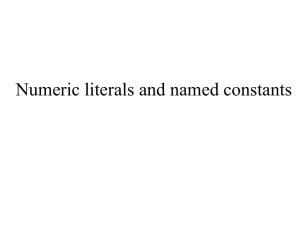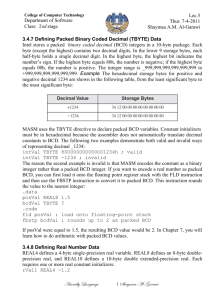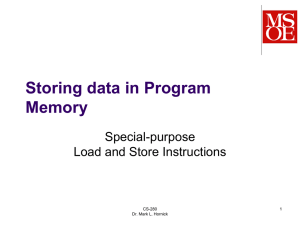Defining Data
advertisement
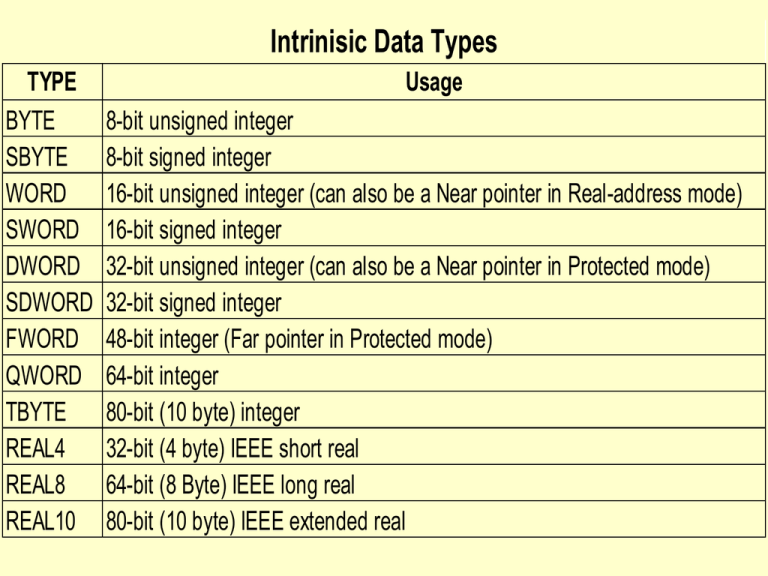
Intrinisic Data Types TYPE BYTE SBYTE WORD SWORD DWORD SDWORD FWORD QWORD TBYTE REAL4 REAL8 REAL10 Usage 8-bit unsigned integer 8-bit signed integer 16-bit unsigned integer (can also be a Near pointer in Real-address mode) 16-bit signed integer 32-bit unsigned integer (can also be a Near pointer in Protected mode) 32-bit signed integer 48-bit integer (Far pointer in Protected mode) 64-bit integer 80-bit (10 byte) integer 32-bit (4 byte) IEEE short real 64-bit (8 Byte) IEEE long real 80-bit (10 byte) IEEE extended real New/Old Assembler Directives New Directives Old Directives BYTE DB W ORD DW DW ORD DD QW ORD DQ TBYTE DT Data Definition Statement • syntax – [name] directive initializer [,initializer]… • At least one initializer is required in a data definition even if it is ? (does not assign a specific value) – The name is a label that marks the offset of a variable from the beginning of its enclosing segment. Examples • • • • • Var1 Var2 Var3 Var4 Var5 BYTE byte db sbyte byte 35h 255 ‘A’ -128 ? ;use h for hex ;case not checked ;old syntax ;signed byte ;uninitialized Defining Lists • • • • .data List List2 List3 byte byte byte byte byte 10, 20, 30, 40 10, 32, 41h, 00100010b 10, 20, 30, 40 50, 60, 70, 80 90, 100, 120 Defining Strings • String1 • String2 • String3 • String4 byte byte byte byte byte \ byte byte byte “This is a string”, 0 ‘T’,’h’,’i’,’s’,‘i’,…. “This is a long string that” “that extends across many” “lines”, 0Dh, 0Ah,0 “Continuation character \ may be” “ used to concatenate two lines” “ into one.”,0 Using the DUP Operator • Generates a repeated storage allocation, using a constant expression as a counter • BYTE 20 DUP(0) – Results in 20 bytes, all equal to 0 • BYTE 20 DUP(?) – Results in 20 bytes, uninitialized • BYTE 4 DUP(“STACK”) – Results in 20 bytes “STACKSTACKSTACKSTACK” Symbolic Constants • Created by associating an identifier with either an integer value or some text. Does not reserve any storage. They are only used during assembly of a program, so they cannot change value during runtime. Equal-Sign Directive • Associates a symbol name with an integer value • .code – COUNT = 500 – Mov al, COUNT • .code – ESC_KEY = 27 – Mov al, ESC_KEY • .data – COUNT = 50 – Array COUNT DUP(0) • Useful for constants. Easy to later change one line of code. Calculating the Sizes of Strings and Arrays • Use the current location counter ($). – List byte 10, 20,30, 40 – ListSize = ($ - list) • The calculation must be done immediately following the list definiton – mystring byte “This is my string”,0 – String_len = ($ - mystring –1) Calculating the Sizes of Strings and Arrays of Words and Doublewords • List WORD 1000h, 2000h, 3000h • Listsize = ($ - list) / 2 • List DWORD 10000000h,20000000h, DWORD 30000000h,40000000h • Listsize = ($ - list) / 4 • This is important when using loops through arrays Lists and Strings List1 db 10, ‘A’, 41h, 0Ah, 00100010b, 101q Listptr db List1 Cstring db “This is a string”,0 Clength = ($ - Cstring) ; sets Clength to length of Cstring Array1 db 20 dup(0) ; 20 bytes, all equal to zero Array2 db 4 dup(“ABC”) ; 12 bytes, “ABCABCABCABC”
